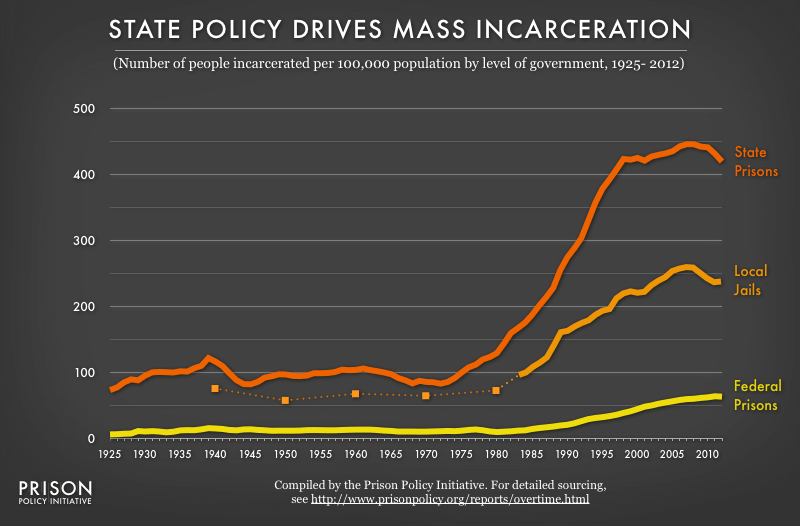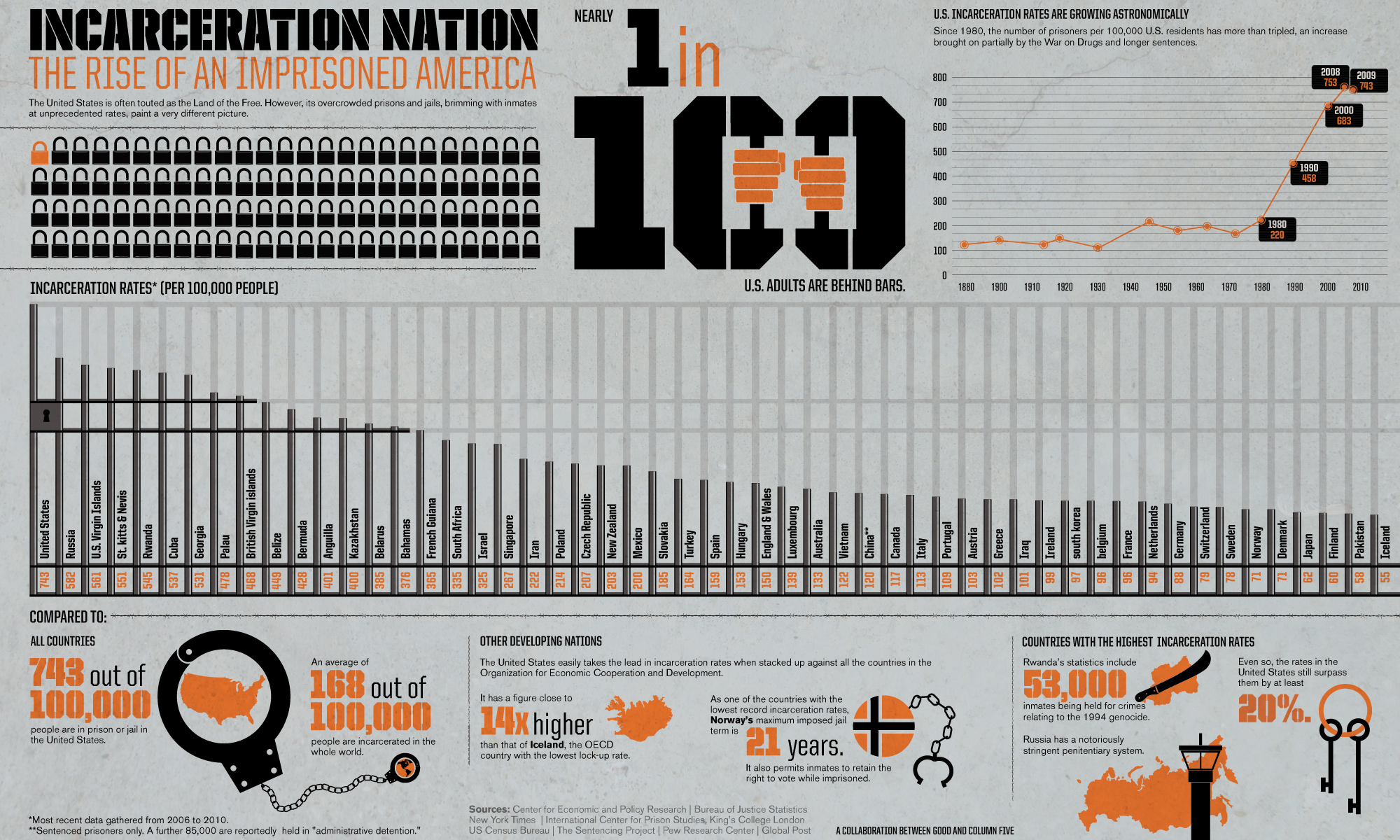History of Race in Mass Imprisonment
By Joshua Woods
The United States of America leads the world in incarceration rate. Numbers have more than quadrupled over the decades. If you want to point the finger, you can blame generations of racism and racial discrimination this nation was born on dating back to slavery. America has never been absolutely free. From slavery, to Jim Crow laws, and now mass imprisonment. The reason I picked these events or eras in history is because they all have ties and contributed to the America being the leader of mass incarceration.
Slavery
The Spanish and Portuguese began bring slaves to the new world (The Caribbean) in the late 1400's and 1500's. Slavery in America didn't really jump until the 1600's. Black slaves were seen as property and not human beings. Taken from their homes, packed like sardines in these boats and shipped the the Americas to be sold to plantation owners. America was built during these times and if a race starts of as slaves, they are going to be looked down upon and treated a certain way.
13th Amendment (End of Slavery)
Following the civil war, the thirteenth amendment was ratified ending slavery and involuntary servitude. The loophole is that it continues by, "... except as a punishment for crime whereof the party shall have been duly convicted.." This made it legal to use criminals pretty much as slaves. Plantation owners needed replacements for slaves so they looked to criminals. Not to forget, even though slavery was ruled out, the southern half of the country was still in favor of it. "In the decades following Emancipation Proclamation, scholars, policymakers, and social welfare reformers had analyzed the disparate rates of black incarceration as empirical "proof" of the "criminal nature" of African Americans." (Hinton) As soon as blacks lost the label as slave, they gained the term criminal.
Convict Leasing to Chain Gangs
Plantation owners did not want to pay employees high wages so they looked to convict leasing. This allowed them to get free work out of convicts. By 1908 this became illegal and chain gangs became the leader for convict working. Convicts no longer worked for private industries. They then worked on the state's chain gang serving the needs of building the roads ultimately helping develop the south. Majority of the chain gang were blacks. Even black women were included in the gang because they were not seen as women.
Jim Crow Laws
This is the system implemented by the south to segregate whites from blacks. This system lasted almost a century from the late 1800's to the mid 1900's. Blacks still weren't seen as equal at this time. The reason I included the Jim Crow Laws in the history of mass incarceration because it built up more tension between whites and blacks that led to rising incarceration rates when it ended. The more blacks fought to be equal, the more whites feared and sought to get rid of blacks. An idea for such was imprisoning them. If they are locked up, they cannot interfere.
War on Poverty turned Crime turned Drugs
President saw fighting crime in a different lens and targeted drugs. "In 1971 Nixon issued a message to Congress on drug abuse prevention and control, in which he declared drug abuse (by which he meant all use of any drug banned by the government) to be "public enemy number one." This was a direct attack on blacks and hippies. Associating blacks with heroine and antiwar hippies with marijuana.
"In the media of the 1960s and '70s, political militants became emblematic, fear -inspiring "criminals." Images of African Americans dominated these representations in newspapers and on television- Black Panthers, political prisoners such as George Jackson ans Angela Davis, and participants in urban rebellions in Watts, Detroit, and Newark," (Kilgore). Blacks, especially the youth, were then labeled super predators, animals, and the main problem with crime in america. Nixon more than doubled the police funding. Making our police more military.
"In the media of the 1960s and '70s, political militants became emblematic, fear -inspiring "criminals." Images of African Americans dominated these representations in newspapers and on television- Black Panthers, political prisoners such as George Jackson ans Angela Davis, and participants in urban rebellions in Watts, Detroit, and Newark," (Kilgore). Blacks, especially the youth, were then labeled super predators, animals, and the main problem with crime in america. Nixon more than doubled the police funding. Making our police more military.
President Reagan, like Nixon, was determined to take on drugs. The biggest target for Reagan was crack cocaine. He took the war even further establishing mandatory sentencing/minimums for crack which were longer than regular powder cocaine. "Under these minimums, more people are sentenced to prison, and they generally stay much longer than under previous sentencing laws," (Kilgore). This was another hit on colored people in America. Blacks and Latinos were caught more with crack because it was cheaper and they were going to jail for life for it. Suburban whites that were caught with powdered cocaine would get only a slap in the wrist. these new sentencing laws more than doubled the prison population over the decades. It went further than a drug ting, it became a race thing. It allowed police to racially target black people. Some of which had to do years in prison for crimes they didn't even commit.
Present Day
The United States accounts for only 5% of the world population but has 25% of the world's prisoners. Billions and billions of dollars are being poured into these prisons. The minorities that make up such a small percentage of the population in America make up a majority of the US prison population. The United States is supposed to be the land of the free but has never been free for all.
Works Cited
"American Anti-Slavery and Civil Rights Timeline." Ushistory.org. Independence Hall Association, n.d. Web. 03 Dec. 2016. <http://www.ushistory.org/more/timeline.htm>.
Hinton, Elizabeth Kai. From the War on Poverty to the War on Crime: The Making of Mass Incarceration in America. Cambridge, MA: Harvard UP, 2016. Print.
Initiative, Prison Policy. "Tracking State Prison Growth in 50 States Tweet !function(d,s,id){var Js,fjs=d.getElementsByTagName(s)[0];if(!d.getElementById(id)){js=d.createElement(s);js.id=id;js.src="//platform.twitter.com/widgets.js";fjs.parentNode.insertBefore(js,fjs);}}(document,"script","twitter-wjs");." Tracking State Prison Growth in 50 States | Prison Policy Initiative. N.p., 28 May 2014. Web. 03 Dec. 2016. <https://www.prisonpolicy.org/reports/overtime.html>.
Johnson, Lyndon B. "Lyndon B. Johnson: Special Message to the Congress on Crime and Law Enforcement." Lyndon B. Johnson: Special Message to the Congress on Crime and Law Enforcement. The American Presidency Project, 9 Mar. 1966. Web. 05 Dec. 2016. <http://www.presidency.ucsb.edu/ws/?pid=27478>.
Kilgore, James William. Understanding Mass Incarceration: A People's Guide to the Key Civil Rights Struggle of Our Time. New York: New, The, 2015. Print.
Unknown. "WEEK 5 Global Interconnections." WEEK 5 Global Interconnections. N.p., n.d. Web. 03 Dec. 2016. <http://www.ccis.edu/courses/hist102mtmcinneshin1/wk05.htm>.




























